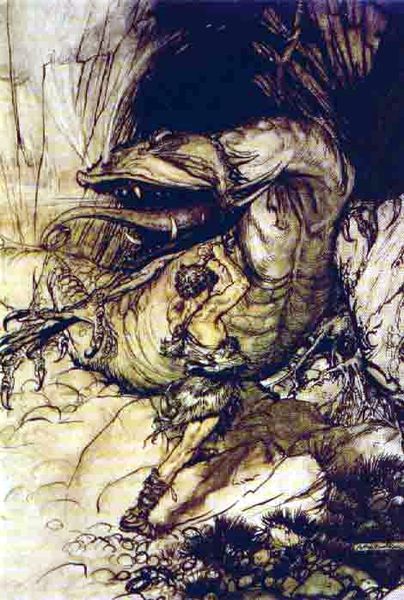A Kill at Ease
When dealing with invulnerability in fantasy stories from the classical to the contemporary, one archetype that shows up from time to time is that of the warrior who is completely indestructible but for one small part of his body. Obviously Achilles, who was immersed in the River Styx by his mother Thetis (or, in other versions, had most of his mortality burned away before his father interrupted) but retained a vulnerable heel, is the most famous example. Interestingly enough, according to the Wikipedia entry, this idea didn't actually come about until the first century AD, with Homer and other early chroniclers of the Trojan War making no note of such a thing. A similar tale is told of the Norse hero Sigurd, better known by his German name of Siegfried. When the greedy dwarf Fafnir (who in Wagner's version was a giant who helped to build Valhalla instead) turned himself into a dragon in order to protect his ill-gotten treasure, Siegfried killed him and bathed in his blood, which made the warrior's body invulnerable. A leaf had gotten under one of his shoulders, however, so that was his equivalent of Achilles' heel, and it was this brother-in-law who eventually did him in. Other figures in the same tradition are the Persian Esfandyar, who bathed in a pool of invincibility but kept his eyes closed (I can't imagine that Achilles or Siegfried could have kept theirs open either, but I guess the Persians thought about such things differently); and the Hindu Duryodhana. This was probably the most X-rated of these stories, as his genitals were his weak spot. His mother used a magic gaze to make Duryodhana's body invincible, but since he was covering his crotch at the time, it wasn't affected.


The idea of a weak spot can also apply to monsters, such as Tolkien's dragon Smaug. Tolkien was quite familiar with Norse mythology, and so presumably would have been aware of both Siegfried's own weak spot and the fact that the hero killed Fafnir in dragon form by stabbing him in the belly. Although the Death Star isn't a living thing, its destruction by exploiting a weak point is accomplished in much the same manner. And sometimes it isn't a body part that is vulnerable, but rather a particular method of killing that has to be used. Examples include the various means of killing vampires (a stake through the heart being the most popular, but far from the only one), silver for werewolves, Kryptonite for Superman, and water for the Wicked Witch of the West. (In fairness, L. Frank Baum never said the Witch was otherwise indestructible, and in fact she probably wasn't, but I'd still say it counts.)


Another variation of the theme came to mind during my reading of Lloyd Alexander's Taran Wanderer. The evil wizard Morda traps his life force in his little finger, which he cuts off and hides. This is the same basic idea as what Voldemort did with his Horcruxes, and it shows up in other stories as well. Heck, even Paper Mario uses that same basic concept with Tubba Blubba's heart.

In some of these cases, it seems like it was only something minor that stopped these characters from being totally invulnerable. For instance, if Siegfried had just thought to check his body for leaves, he wouldn't have HAD the weak spot. But I think there's a little more to it than that. It's a general rule in stories that involve magic that none of it can be absolute. Every spell has its counterspell, every curse has its loophole, and everyone who's otherwise invincible has to have a weakness.


The idea of a weak spot can also apply to monsters, such as Tolkien's dragon Smaug. Tolkien was quite familiar with Norse mythology, and so presumably would have been aware of both Siegfried's own weak spot and the fact that the hero killed Fafnir in dragon form by stabbing him in the belly. Although the Death Star isn't a living thing, its destruction by exploiting a weak point is accomplished in much the same manner. And sometimes it isn't a body part that is vulnerable, but rather a particular method of killing that has to be used. Examples include the various means of killing vampires (a stake through the heart being the most popular, but far from the only one), silver for werewolves, Kryptonite for Superman, and water for the Wicked Witch of the West. (In fairness, L. Frank Baum never said the Witch was otherwise indestructible, and in fact she probably wasn't, but I'd still say it counts.)


Another variation of the theme came to mind during my reading of Lloyd Alexander's Taran Wanderer. The evil wizard Morda traps his life force in his little finger, which he cuts off and hides. This is the same basic idea as what Voldemort did with his Horcruxes, and it shows up in other stories as well. Heck, even Paper Mario uses that same basic concept with Tubba Blubba's heart.

In some of these cases, it seems like it was only something minor that stopped these characters from being totally invulnerable. For instance, if Siegfried had just thought to check his body for leaves, he wouldn't have HAD the weak spot. But I think there's a little more to it than that. It's a general rule in stories that involve magic that none of it can be absolute. Every spell has its counterspell, every curse has its loophole, and everyone who's otherwise invincible has to have a weakness.